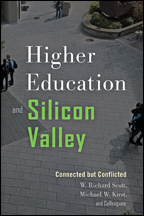What is the value of higher education, particularly in the heart of one of the most dynamic economies on earth? According to researchers Dick Scott and Mike Kirst, two emeriti Stanford faculty members, the fundamental issues facing institutions that make this area their home illustrate how challenging it is to prepare new generations to operate successfully in a region that attracts talent from all over the globe.

In their new book, Higher Education and Silicon Valley, the authors argue that universities and colleges operate between two worlds: the traditions of education and the dynamics of the economic systems that surround them. In particular, research institutions, rooted in government funded post-graduate studies, are losing their appeal to students opting for more practical and immersive options that prepare them for success in the industrial opportunities they find here.
At the root of their research is the identification of a fundamental “mismatch” between traditional academics and the needs of industries increasingly searching for new talent. Specifically, they note the various informal structures that enable professionals to stay on top of ever changing technology-driven business opportunities. To fill the gap has emerged a range of professional associations, adult education programs, bootcamps and immersive, team-oriented curricula like those found at USV.
Says Kirst, “At the policy level, we’re operating under a master plan for higher education that was approved in 1960 and has never been overhauled in a major way since then. For example, the master plan didn’t anticipate an economy that needed so much rapid reskilling of adults – many of whom have a solid education. The regional economy changes at an exponential rate whereas the higher education sector experiences at best incremental change.”
The authors and their team’s research points to two trends which the authors believe will continue to grow. To begin with, pure liberal arts programs have become hard to justify as students and their parents demand an educational experience rooted in more professionally-oriented challenges. To address this demand, institutions have moved away from a tenured faculty approach in favor of hiring more industry practitioners to bring the latest technologies and practices to the student.
While their work does not address what practices seem to work best within higher education, the authors have done a remarkable job identifying over 300 institutions within the greater Silicon Valley region, of which less than a third are fully accredited, degree granting institutions.
For anyone investigating their options when choosing a college or other pathway into what is emerging as a global economy, the authors provide a useful starting point.


